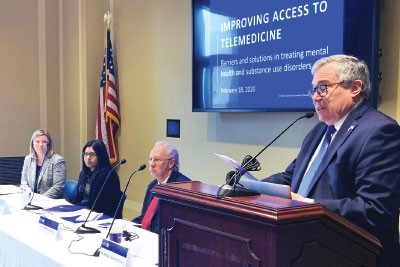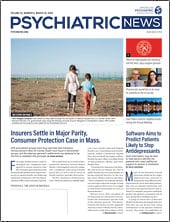Before he got involved in telemedicine, Robert Caudill, M.D., saw a patient from a rural Kentucky community with severe suicidal ideation. “Every day of her life, she wondered why she should live beyond the sunset,” Caudill said.
The patient remained in Caudill’s care even as he moved around the area, sometimes between states. She would drive across massive bridges stretching over wide expanses of water for her appointments. “She’s thinking: What a perfect day it would be to jump off that bridge,” Caudill said. During the sessions he would ask her, “How did the bridge go today?”
If telemedicine had been available at that time, that patient could have had a very different experience, said Caudill, director of telemedicine and information technology programs at the University of Louisville School of Medicine. He shared his story during a congressional briefing last month on Capitol Hill titled “Improving Access to Telemedicine: Barriers and Solutions in Treating Mental Health and Substance Use Disorders.”
APA and the American Association of Child and Adolescent Psychiatry co-hosted the briefing, which was sponsored by Rep. Mike Thompson (D-Calif.), who has supported legislative initiatives to improve access to telemedicine.
“We’re facing a disparity between the availability and the increasing need for mental health and substance use treatment services,” said APA President Bruce Schwartz, M.D., who moderated the briefing. “A growing body of research indicates that psychiatric care provided via telehealth is as effective as in-person psychiatric services. In fact, sometimes patients prefer telepsychiatry because of its convenience and as a means of reducing stigma.”
Two studies published in the February Psychiatric Services reported on telemedicine’s use and effectiveness. One paper noted a survey that found that 20% of 4,500 emergency departments (EDs) used telepsychiatry, and in 95 EDs, more than half used no other emergency psychiatric services. The other study involved a pilot program that used telepsychiatry to help identify and treat women with perinatal depression. More than 700 patients were screened for depression, and 19% were referred to behavioral health services. Of those, 96% engaged in treatment, a rate far surpassing national treatment engagement estimates of 60% or less.
Caudill and Shabana Khan, M.D., director of telemedicine for the Child Psychiatry Department at NYU Langone Health, shared their experiences with telemedicine and its ability to reach patients in both rural and urban settings. Both Caudill and Khan are members of APA’s Committee on Telepsychiatry, and Khan is co-chair of the American Academy of Child and Adolescent Psychiatry Telepsychiatry Committee.
In rural areas, many families have limited resources or none at all. “Significant time and money are saved if you don’t have to travel for care,” Khan said. Urban families, too, encounter barriers, such as parents not being able to take time off work or children having to miss school for appointments. With telepsychiatry, Khan said, “we’re able to meet the children where they are. If we didn’t have this ability, a lot of the children, adolescents, and families would go without care.”
Despite its effectiveness, the use of telepsychiatry is hampered by numerous barriers. For example, the Ryan Haight Act requires any physician issuing a controlled substance to conduct an initial, in-person medical evaluation, a burdensome rule in telemedicine. Additionally, under Medicare, patients seeking tele-mental health care must go to an “originating site,” which refers to the site where a Medicare beneficiary receives medical services through a telecommunications system, such as a physician’s office or health clinic. In 2019, Congress allowed a patient’s home to function as an originating site and removed the geographic restrictions for patients receiving treatment for substance use disorders and co-occurring mental disorders, but not for patients receiving treatment for other mental or behavioral health treatment.
“A sick person is a sick person, and we should be able to take care of people where they live,” Caudill said. Because Kentucky has lifted restrictions, he can see patients in their homes via telemedicine. “It’s a very cool thing to be making house calls again,” he said. “We learn a lot when we beam into patients’ houses.”
Khan pointed out that lifting telemedicine restrictions from Medicare will have far-reaching implications, as private payers and Medicaid plans often follow Medicare’s lead. Khan has been doing telemedicine for about a decade, and she said she has many patients whom she has never met in person. Khan explained that she has protocols to ensure an initial telemedicine assessment meets the same standard of care as assessments completed in person.
“Early intervention is so important for the conditions we treat,” she said. “If we had to do that in-person examination initially before starting telehealth, we would not be able to reach a significant portion of the population that really needs this care.”
Three bills before Congress would eliminate the geographic requirements and allow Medicare coverage for in-home telepsychiatry: EASE Behavioral Health Services Act (HR 5473) and Telemental Health Expansion Act (HR 5201) have been filed in the House, and the CONNECT for Health Act (H. 4932/S 2741) has been filed in both the House and Senate. APA supports all three pieces of legislation.
Bill Bradley, a patient and ambassador with Shatterproof, a national nonprofit advocating for substance use disorder treatment, was unable to attend the briefing. Bradley, a veteran and West Virginia resident recovering from substance use disorder, could not reschedule an appointment with his physician, whom he sees in person every few months in addition to regular telemedicine appointments.
In a statement read by a Shatterproof representative, Bradley said his arrangement with his physician through the Veterans Health Administration saves him hours on the road and has allowed him to maintain his relationship with his physician for about a decade. He said he’d like those in the civilian health care system to have similar continuity.
“It is not uncommon for patients to travel three or more hours, even out of state, to wait two or more hours before seeing a doctor for medication management, then to travel to an authorized pharmacy, then to get home another few hours later,” Bradley said in his statement. “In my opinion, that’s the definition of a broken health system that’s preventing many from getting the care they need.” ■
“Telepsychiatry Use in U.S. Mental Health Facilities, 2010–2017” is posted
here.
“Evaluation of Telepsychiatry-Enabled Perinatal Integrated Care” is posted
here.

